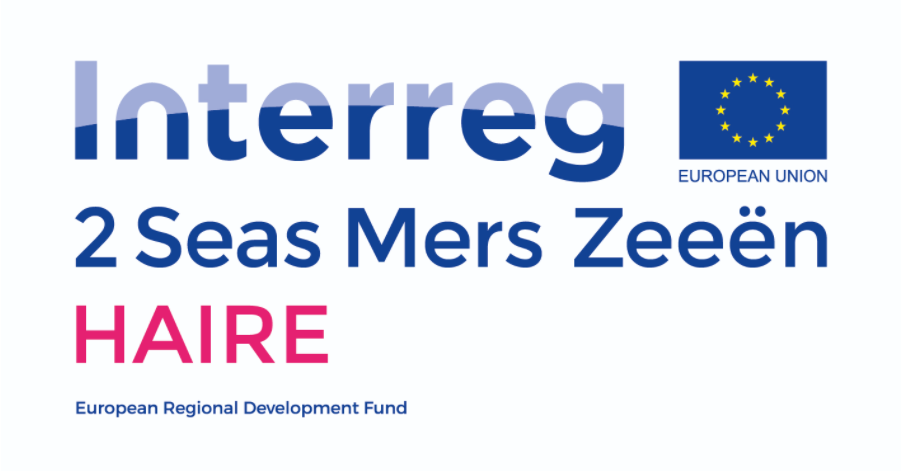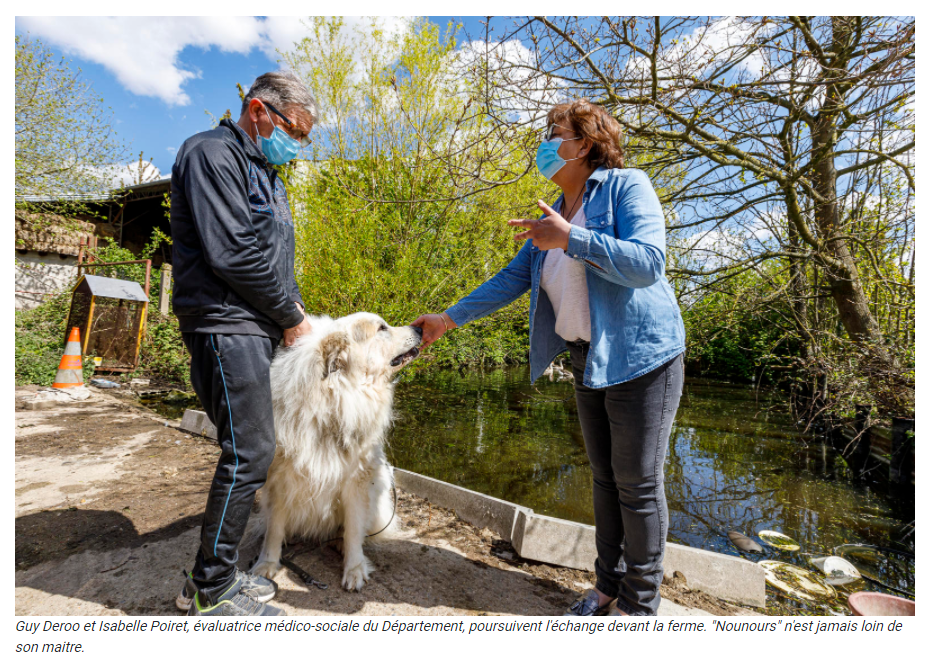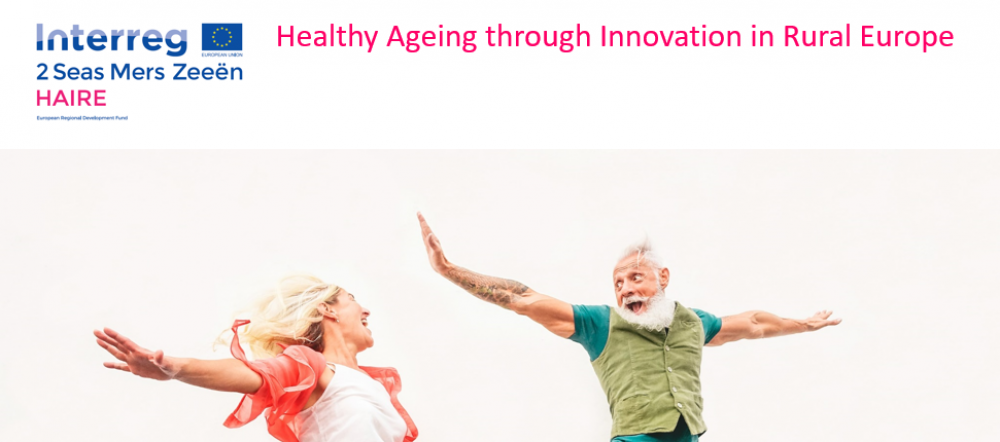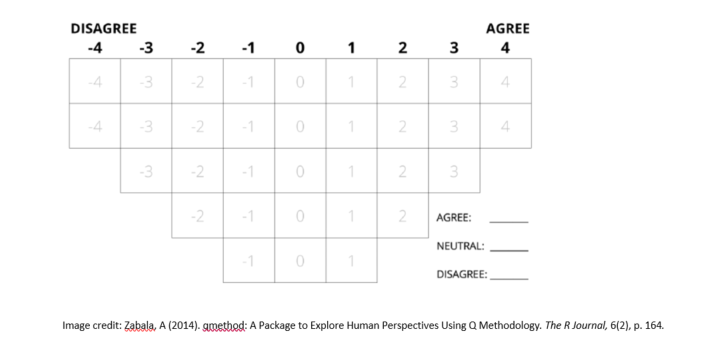A recent article published by the Département du Nord, one of our project partners in France, brings the interview process to life for those new to HAIRE and the Guided Conversation technique. The article appears below in its original language, and is followed by a translation into English by our French intern, Valentine Naude.
Conversations guidées pour séniors isolés
25 Mai 2021
Le Département participe au projet européen HAIRE qui vise à identifier les besoins et envies des personnes âgées isolées grâce à des conversations guidées. À Arnèke, Jocelyne et Guy Deroo ont pu y participer. Rencontre.
Pour arriver chez Jocelyne et Guy Deroo, mieux vaut avoir un bon GPS. L’ancien corps de ferme qu’ils habitent est situé aux confins du village d’Arnèke, tout au bout d’un long chemin de terre.
Une fois sur place, plus que la cloche un peu fatiguée par les années, c’est “Nounours” qui se charge de prévenir de votre arrivée. L’impressionnant chien de montagne des Pyrénées (65 kg !) est l’un des nombreux animaux à tenir compagnie au couple, très isolé.
Nous sommes ici depuis 20 ans mais nous ne connaissons personne
, explique Guy. Nous n’avons presque pas de famille non plus, et au fil des années, les liens se sont distendus. Et puis notre boîte aux lettres est là-bas, au bord de la route, alors je ne vois même pas le facteur.
Jocelyne, son épouse, souffre d’importants problèmes de santé qui entravent grandement sa mobilité. Coincé dans sa maison isolée au beau milieu de la plaine flamande, le couple ne voit plus que l’auxiliaire de vie qui passe quotidiennement.
Identifier les besoins des séniors isolés
C’est dans le cadre du projet européen HAIRE (Healthy Aging Innovation in Rural Europe) que Jocelyne et Guy ont fait la connaissance d’Isabelle Poiret, évaluatrice médico-sociale au Département.
 Le projet, qui s’intitule en français “Vieillir en bonne santé grâce à l’innovation dans l’Europe rurale”, consiste à mener une étude sur la situation d’isolement des personnes âgées. Il est notamment basé sur le principe de la conversation guidée.
Le projet, qui s’intitule en français “Vieillir en bonne santé grâce à l’innovation dans l’Europe rurale”, consiste à mener une étude sur la situation d’isolement des personnes âgées. Il est notamment basé sur le principe de la conversation guidée.
La conversation guidée est un entretien semi-directif qui dure généralement entre deux et trois heures. À partir de thématiques larges (la vie personnelle et professionnelle, l’environnement de vie, les centres d’intérêt, etc.) et de quelques images, nous invitons les personnes à nous parler d’elles-mêmes
, explique Isabelle Poiret.
Les entretiens sont ensuite retranscrits et analysés par l’université d’Artois, l’un des partenaires français du Département dans le projet HAIRE. Avec l’aide de l’association Unis-cités, le Département a prévu de mener 150 conversations guidées. Des conversations loin d’être anodines
et dans lesquelles, de l’avis même de la professionnelle du Département, il y a un investissement réciproque
.
Pour Guy et Jocelyne Deroo, Isabelle Poiret a une vraie qualité d’écoute qui nous a mis en confiance. Le contact est bien passé et après sa venue, on était contents. Ce projet recrée du lien et donne envie de reprendre des activités.
 Les deux séniors ne demandent pas grand chose : trouver des gens pour jouer au tarot, réapprendre à jouer aux échecs, aller au musée de Flandre à Cassel, partir quelques jours en Normandie avec leur camping-car, … Et surtout, ne plus être esseulés.
Les deux séniors ne demandent pas grand chose : trouver des gens pour jouer au tarot, réapprendre à jouer aux échecs, aller au musée de Flandre à Cassel, partir quelques jours en Normandie avec leur camping-car, … Et surtout, ne plus être esseulés.
Beaucoup de séniors se résignent et ne s’autorisent plus à dire “j’ai envie de”. Pourtant, ils ne demandent généralement que de petites choses qui nous semblent anodines mais améliorent vraiment leur quotidien. Isabelle Poiret
Ce qui ressort le plus, c’est l’envie de sortir et de revoir ses proches. L’autre jour, j’ai juste accompagné une dame jusqu’à sa boite aux lettres : c’était son bonheur de la journée
, ajoute-t-elle.
En pleine crise sanitaire, la conversation guidée a dépassé ses objectifs : elle s’est transformée en outil de lutte contre l’isolement. Pour Isabelle Poiret, c’est donc bien plus qu’une étude. C’est une action à part entière et une véritable expérience humaine.
Un rapport intermédiaire a déjà été produit afin que les partenaires puissent commencer à se mobiliser sur le territoire. À partir des envies exprimées par les séniors isolés, deux axes de travail sont envisagés : mieux faire connaître aux personnes âgées ce qui existe déjà pour elles et proposer des solutions innovantes.
Dans six mois, quand je retournerai voir Jocelyne et Guy Deroo, et tous les autres, j’espère bien pouvoir leur proposer des choses !
, conclut Isabelle Poiret.
Crédits photo : C. Arnould
English Translation
Guided Conversations for isolated older people
The Département du Nord is part of the European project HAIRE, aiming to identify the needs and desires of isolated older people through Guided Conversations. In Arnèke, Jocelyne and Guy Deroo were able to participate.
If you are on your way to the Deroo’s, you’d better have a good Sat Nav. The old farm buildings they live in stand at the edge of the village of Arnèke, at the very end of a long dirt track.
Once you get there, “Nounours” (“Teddy Bear”) takes it upon himself to warn the couple of your arrival (more so than the bell, a little weathered by time). The imposing Pyrenean Mountain Dog (65 kg!) is one of the many animals that keep them company in their isolation.
“We’ve been here for 20 years now, but we don’t know anyone”, Guy explained. “We barely have any family; the bonds have stretched thin. And our letterbox is all the way over there, by the road, so I don’t even get to see the postman.”
His wife Jocelyne suffers from serious health problems that greatly hinder her mobility. The couple, being stuck in a secluded house in the middle of the Flemish region, only ever see their carer who comes by every day.
Identifying the needs of isolated older people
Jocelyne and Guy met Isabelle Poiret, the Département’s medico-social evaluator, through the European project HAIRE (Healthy Ageing through Innovation in Rural Europe).
The project involves carrying out a study on the isolated situation of older people. It notably makes use of the Guided Conversation tool.
“A Guided Conversation is a semi-structured discussion that generally lasts from two to three hours. Starting off with general themes (personal and professional life, living environment, main interests, etc) and a few images, we encourage people to tell us more about themselves”, explained Isabelle Poiret.
The discussions are then transcribed and analysed by the University of Artois, one of the Département’s French partners within the HAIRE project. With the support of the organisation Unis-cité, the Département is planning on carrying out 150 Guided Conversations. “Far from being trivial”, these conversations show there is “a mutual commitment”, said the Département’s evaluator.
According to Guy and Jocelyne Deroo, “Isabelle Poiret has a great ability to listen which got us to open up to her. There was a real connection there and we were happy after she came to see us. This project is creating bonds and is making us want to pick up activities.”
Caption: Guy Deroo and Isabelle Poiret, the Département’s medico-social evaluator, discussing in front of the farm. “Nounours” never strays far from his owner.
The two older people are not asking for much: finding people to play tarot with, learning how to play chess again, going to the Flandre museum in Cassel, going to Normandy in their camper van for a few days… But mostly, not to be lonely anymore.
“Many older people resign themselves to this and don’t allow themselves to say “I want to”. And yet, they usually only ask for small things that seem trivial to us but truly improve their everyday life.” Isabelle Poiret
“What stands out the most is the desire to go outside and see their loved ones again. The other day, all I did was walk an old lady to her letterbox, and it was the highlight of her day”, she added.
During this health crisis, the Guided Conversations have exceeded their objectives, changing into a tool for combatting isolation. Therefore, for Isabelle Poiret, this is way more than a study. “This is a fully-fledged action and a real human experience.”
An initial report has already been drafted so our partners can start going into action on the field. From the desires expressed by isolated older people, two areas of work are being considered: helping older people know what already exists, and offering innovating solutions.
“Six months from now, when I come back to see Jocelyne and Guy Deroo and all the others, I sure hope that I’ll be able to offer new things!” concluded Isabelle Poiret.
Photo credit: C. Arnould


